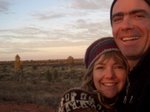
The mountain produced fabulous wealth for over three centuries and the city became one of the largest in the Americas. According to official records, 45,000 tonnes of pure silver were mined during the 15, 16 and 1700s. All of this was exported. The town itself is largely a collection of makeshift dwellings, except in the very centre, where silver was said to flow in the streets. I would be surprised if every street has running water.
The vast majority of this wealth flowed to Spain, and at a huge human cost. To supply the world's demand for silver, people were brought from Bolivia, Peru, Argentina and Chile to work in the traditional Incan institution of mita - enforced labour. They died by the thousands from the brutal conditions and lung poisoning. An estimated 30 000 people were also brought from Africa to face the same conditions. In total, it is said, eight million slaves may have died here. The mine took on the name 'the mouth of hell'. In fact, miners there today still give offerings to the devil, who is responsible for their saftey underground.
Our tour of the mine included a visit to a local refinery (Boliva doesn't have the technology for a smelter, so all ore is exported. Even half the refineries are foreign-owned). As we looked across the shanty-suburbs to the mountain we were told that experts have indicated it is past its used-by date, due to collapse about five years ago. Workers live with this knowledge every day, as well as the fact that they will probably die of accident or lung poisioning before they are 60. Most have incurable respiratory system diseases within ten years of entering the mines.
We were stunned by the conditions inside the mine. Despite the scarves over our faces, it was terribly difficult to breathe. The air (lacking oxygen even outside, the city is over 4000m above sea level) was full of thick sulphorous-smelling dust. Who knows what else it carried - the crystals I noticed hanging from the roof turned out to be asbestos.
As we walked, stooping, deeper into the mine I wondered how we were going to spend two hours in there. The first workers we passed - hauling a trolley full or ore with sweat all over thier bodies and blank expressions on thier faces - put my difficulties into perspective. Only the devil knows how many of these they have moved.
We descended deeper into the mine, slipping down dusty tunnels and along low corridors, intermittentently jumping out of the way of the trolley-haulers. The air got hotter and more oppressive. On the third level we stopped where a group of men were shovelling ore (dumped by the trolley-haulers) into a bucket to be winched to the level above. We had a go shovelling - Andy put in quite an effort, and quickly learnt why the miners don't wear masks, manual labour under those conditions requires all the air one can get, dust or not. As they shovelled, I wondered how long the roof above their heads would hold.
Our last challenge was to climb an unused route from the third to the second level without the guide. After hearing the instructions three times ('take the very left tunnel, do a dog leg, follow that tunnel [which involved sliding on our stomachs] for 45 m, dont look down the shaft on the right, the last time someone did that, they fell down and died ... don't worry, it was a miner, not a tourist ... and follow the small pipe up to the second level'), our small group set off, Andy leading.
The small pipe turned out to lead us up a steep path, apparently cut with steps that were impossible to discern as they were covered with slippery mud. As I tried not to think about the shaft below, I wondered when the guide had last taken this path, and if he knew it had water all over it. But then again, he was an ex-miner, and when he worked the mine, they had no electric winch and it was his job to carry 40 - 50 kgs of ore (almost his weight) up from the third level outside, about 50 loads a day. So I guess he knows about slippery tunnels.
Back on the first level we headed towards the light as quickly as the treacherous, muddy path would allow. After just two hours down there, we were glad to be out of that hell on earth, and to breath (relatively) freely again.
However we didn't forget the people still down there. Slaves to the silver they would never get to see.

























































No comments:
Post a Comment